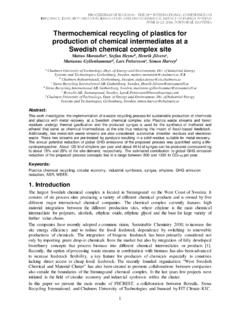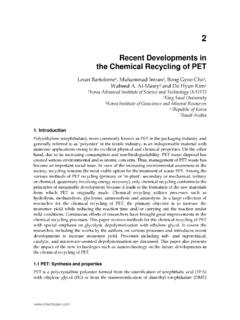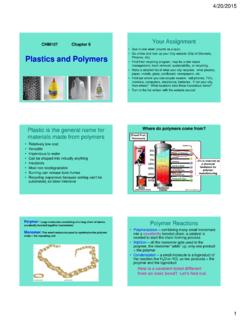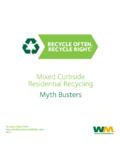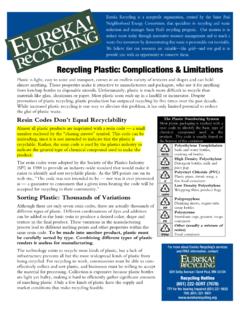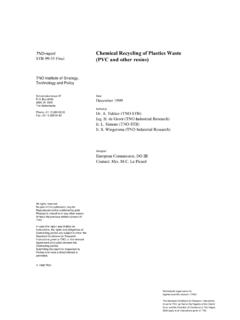Transcription of Plastics Analysis Lab Lesson Plans - Monroe County
1 Plastics Analysis Lab Table of Contents Lesson Plans - Exploration - Previous Week - Day One - Concept Introduction - Day Two - Plastics Analysis Lab - Answers to "Conclusion" questions - Concept Application - Day Three - Appendix: Classroom worksheets - Table of Plastic Resin Identification Codes Appendix A. - Classification of Plastic Containers Appendix B. - Plastics Analysis Lab Appendix C. - Observations and Notes on Reactions Appendix D. - Conclusions Appendix E. - Assessment of Plastic Container Classification Appendix F. Exploration What do the students already know? What will happen This part of the learning cycle actively involves the student with his or her peers with minimal teacher input. Previous Week: Students bring to class plastic containers with resin identification codes embossed on them (1-6). An example of the code: You will notice that in the cases of codes #1 and #3 we refer to the resins as PET and PVC, respectively.
2 However, the actual codes on the containers are PETE and V. These resins are correctly referred to in both ways. It might be a good idea to award bonus points for samples brought to school so that each class has a wide variety of containers to study. The containers are collected in a large box in the classroom. Before the first class period on the study of Plastics , the teacher must remove the embossed code on the bottom of the containers. Just cut down the side of the container and remove it. It is okay to partially destroy the container! It is not necessary to save the codes nor to identify which container was coded with a particular number. Student groups may be given pieces of containers for this activity. They do not need the whole container. It works well to have plastic bags of containers ready for each group in the class. Day One: Introduce the topic of Plastics by asking your students what comes into their minds when the word "plastic" is heard.
3 At some point in the discussion, the resin identification codes will be mentioned. Ask your students what they think the numbers mean. Finally, place an overhead transparency of "Plastic Resin Identification Codes" on the overhead projector (using the handout included in Classroom Materials below to make a transparency) and tell them the names for the letter abbreviations. At this point it is not expected that students will know what is meant by the long chemical names but the introduction is important. Place students into cooperative groups. Give each group a felt tip marker, a bag of plastic containers with the plastic code removed, and the sheet Classification of Plastic Containers (see Classroom Materials below). Challenge the groups of students to put the containers in their appropriate groupings (1-6). These are: (1) PET, (2) HDPE, (3) PVC, (4) LDPE, (5) PP, (6) PS.
4 Sharing their ideas with others in their group and recording their thoughts is appropriate. A. student recorder should be assigned to each group. Toward the end of the class period, one representative will share with the class their classifications of the containers and how the group arrived at their decisions. A lively discussion may occur because the students don't have much information about the categories. Keep each group's categories of Plastics in a separate place or in a bag marked for that group. These will be used later. A marker should be used to identify each container with the plastic number that they assigned. Classroom worksheets (see Appendix): - Table of Plastic Resin Identification Codes - Classification of Plastics Containers Concept Introduction Day Two: The teacher plays an active role in the introduction of new ideas. This is a laboratory exercise where students work in pairs or small groups.
5 The Plastics Analysis Lab may take two days for larger classes. Use the enclosed student laboratory instructions and worksheets for this activity. Plastics Analysis Lab (modified from Christopher S. Kollman, Chem 13 News, January 1994). 1. Before conducting this lab, students should be familiar with the concept of density. 2. If students are not familiar with flow charts, we suggest that you try having them read the chart and discuss its meaning before the lab. Have students tell which plastic floats in alcohol and oil. Will this same plastic float in water? Which plastic has a green flame with the copper wire test? Will PS soften in acetone? 3. The four test areas must be set up before the class starts. Be sure to keep the flammable liquids and the hot plate in separate locations for safety reasons. Also, make sure students wear safety glasses and avoid breathing in fumes during the experiment.
6 4. If you do not want your students to have open flames in the room to do the copper wire test, have your students bring the resin to you to demonstrate this test for them. Using insulated copper wire by peeling off the end of the insulation also works well for this test. 5. Each group of students needs samples of the six recycled resins to identify. Each group should have about 10 pellets of each type. 6. Acetone is the active ingredient in some fingernail polish removers so your drugstore is a good source for this chemical . Please read the label of the fingernail polish remover to make sure that the primary active ingredient is acetone. If you use fingernail polish remover instead of acetone, students must leave the plastic sample in the liquid for a longer period of time in order to detect any softening of the plastic. Please check the timing of this test before the students do the lab.
7 A special container must be provided for the used resins since acetone on the pellet may be a fire hazard until the acetone evaporates. 7. Isopropyl rubbing alcohol is also available from the drugstore, but make sure it is 70. percent to 90 percent, since the density is not one gram/mL. When preparing the materials listed on page 27, 60 grams of isopropyl rubbing alcohol is equal to 65 mL for the alcohol solution. 8. Mazola corn oil has the correct density to separate #4 and #5 resins so do not substitute another kind of oil. 9. Have your students place their used resins in appropriate containers at the end of the laboratory period so that you can recycle them for another class. Have labeled containers set up for the each resin. 10. The PET resin in this kit does not soften in boiling water for the heat test. Students will not have to use this test to distinguish between PS and PET because the acetone test will identify both.
8 Most bottles made out of PET will soften in boiling water, so students can use this property when testing containers. To demonstrate this in class, simply use pre-cut strips of soda bottles. Answers to "Conclusion" questions 1. Identify the resins by color. 1. PET Polyethylene Terephthalate (white). 2. HDPE High density Polyethylene (off-white). 3. PVC Polyvinyl Chloride (gray). 4. LDPE Low density Polyethylene (brown). 5. PP Polypropylene (black). 6. PS Polystyrene (blue). 2. HDPE, LDPE and PP because their densities are less than g/mL. 3. Do not use PET because it softens at 100 degrees Celsius. 4. The bottle was made of PS since it softens in acetone or fingernail polish remover. 5. The alcohol solution was about g/mL since HDPE sinks in this solution. 6. Adhering air bubbles will add buoyancy to the sample and therefore the density will be less than expected.
9 7. The mixture of LDPE and PP will not show up in the water density test since their densities are so similar. A mixture of PET and HDPE will change the density depending on how much of each is present in the mixture. Classroom worksheets (see Appendix): - Plastics Analysis Lab - Observations and Notes on Reactions - Conclusions Concept Application Can students take the containers that they originally classified in Day One and check their accuracy? Day Three: Student assessment will be done in the laboratory setting. The original groups of students from Day One will perform tests on their containers to see if they were correct in their groupings of the Plastics . (Use this section's student data sheet, "Assessment of Plastic Container Classification."). Allow students to make changes to their groupings after their laboratory experience with the resins but before they actually test the containers.
10 Assessment is based on students being able to follow the flow chart using their plastic containers, not the resins. Each container must be tested by cutting a 1 cm X 1 cm piece or by using a hole punch to obtain the circle for test purposes. Grading is NOT based on the correctness of the original groupings! At this point it is possible to observe the groups at work for a general grade or to give a written assignment for the group to explain their results. Another way to assess students' thinking about Plastics is to have them draw a cartoon-type sketch telling the different steps needed in a factory to separate Plastics for recycling. Challenge students to make this efficient, cost-effective, a good use of man/woman power, etc. Students could also be encouraged to make a videotape of their "factory." Local groups that recycle Plastics could be invited to speak to the class or a field trip might be possible.

